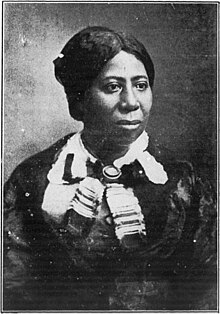Anna Murray-Douglass
Anna Murray-Douglass (* 1813 in Denton, Maryland , † August 4, 1882 in Washington, DC ) was an American abolitionist and member of the Underground Railroad network .
Life
Early years
Anna Murray was born in Denton, Maryland in 1813. Her parents were Bambarra and Mary Murray. Contrary to what was long assumed, Anna was not the first of her siblings to be born free . Original documents discovered later prove that their older siblings Philip and Elizabeth were also born free. Because of this, her mother was released from slavery in the 1800s . Caroline County, Maryland records currently in the State Archives indicate that Anna and her siblings Charlotte, Elizabeth, and Philip received Certificates of Freedom from the District Court on May 29, 1832. They were officially considered free people and were allowed to travel freely through Maryland without being able to be enslaved again. Anna moved with her siblings to Baltimore , Maryland, and was able to secure herself financially as a washerwoman and housekeeper. She got to know the slave Frederick Bailey at the harbor , who worked there as a caulk , and was able to help him escape.
Family and abolitionist activities
Anna's freedom reinvigorated Frederick's desire to escape slavery himself. So Anna encouraged him and gave him a sailor's uniform that she found in her laundry. By selling one of her feather beds, she was able to give him some of her savings with him on the escape route. Frederick came to New York via Philadelphia , Pennsylvania, where Anna followed him to start their own household together. In order to disguise his identity as a refugee, he changed his last name first to Stanley and then to Johnson . They married on September 15, 1838 and initially took the common family name Johnson , which they later changed to Douglass when they moved to New Bedford, Massachusetts .
Within the first ten years they had five children: Rosetta , Lewis Henry , Frederick Jr. , Charles Remond and Annie, who died at the age of 10. In order to be able to support the family financially, Anna worked as a laundress and learned how to make shoes, because Frederick's income was too irregular. Anna also took an active role in the Boston Female Anti-Slavery Society and campaigned for Frederick's training as a typesetter for his abolitionist newspaper The North Star . After the family moved to Rochester, New York , Anna established the headquarters of the Underground Railroad network in her home, providing food and clean linen for slaves fleeing for Canada .
Anna was barely mentioned in three of Frederick's autobiographies. In the New York Times , Henry Louis Gates, Jr. wrote in 1995 that "Douglass turned his life story into a political diorama in which Anna was not part of". Frederick's prolonged absences from home and Anna's feeling that, as a relatively uneducated woman, did not fit into the social circles in which Frederick was associated, resulted in a certain estrangement between the two. Through friendships and professional relationships with other women, Frederick Anna became unfaithful. Still, she unconditionally supported Frederick's public role and continued to love him. Her daughter Rosetta Douglass Sprague remembered her father and his "story made possible by the unshakable loyalty of Anna Murray" in Foner's Lift Every Voice: African American Oratory in 1998 .
Retirement
After the death of her youngest daughter Annie at the age of 10, Anna was often in poor health. In August 1874 she was visiting the Gibson Valentine family in the far northeast of Maryland. When it returned to Elkton station after a few days , it enjoyed great popularity among the population. According to Cecil Whig , the local newspaper for Cecil County , Maryland, it was celebrated.
On August 4, 1882, Anna died of a stroke in Washington, DC . She was originally buried there in Graceland Cemetery . After its closure in 1894, it was transferred to Mount Hope Cemetery in Rochester, New York, on February 22, 1895 . Frederick was buried next to her after his death on February 20, 1895.
Literature and web links
- Rosetta Douglass Sprague: My Mother As I Recall Her . In: Philip S. Foner, Robert J. Branham (Eds.): Lift Every Voice: African American Oratory, 1787-1900 . Tuscaloosa 1998, ISBN 0-8173-0848-2 , pp. 897 ff .
- Leigh Fought: Women In The World Of Frederick Douglass . New York 2017, ISBN 978-0-19-978237-6 , pp. 41-69 .
- Julius E. Thompson et al .: The Frederick Douglass Encyclopedia . Greenwood, Santa Barbara 2010, ISBN 978-0-313-31988-4 , pp. 44, 124 f .
- Shirley Yee: Anna Murray Douglass (c. 1813-1882). BlackPast.org, February 11, 2007, accessed June 25, 2020 .
- Discovering Anna Murray Douglass. SouthCoastToday, February 17, 2008, accessed June 25, 2020 .
Individual evidence
- ^ Janus Adams: Sister Days: 365 Inspired Moments in African American Women's History . Wiley, New York 2000, ISBN 0-471-43702-6 , pp. 8 .
- ^ Waldo E. Martin, Jr.: The Mind of Frederick Douglass . Chapel Hill 1984, ISBN 0-8078-1616-7 , pp. 3-17 .
- ↑ Local News . In: Cecil Whig . August 29, 1874.
- ^ John Muller: Frederick Douglass in Washington, DC: The Lion of Anacostia . The History Press, Charleston 2012, ISBN 978-1-60949-577-0 , pp. 129-152 .
- ^ Douglass' Memory . In: The Evening Star . February 23, 1895, p. 14 .
| personal data | |
|---|---|
| SURNAME | Murray-Douglass, Anna |
| ALTERNATIVE NAMES | Murray, Anna (maiden name); Murray-Johnson, Anna (married name); Murray-Douglass, Anna (married name changed) |
| BRIEF DESCRIPTION | American abolitionist |
| DATE OF BIRTH | 1813 |
| PLACE OF BIRTH | Denton, Maryland |
| DATE OF DEATH | 4th August 1882 |
| Place of death | Washington, DC |

